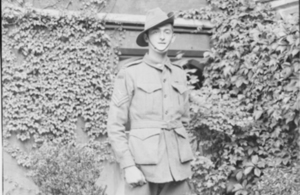WW1 Australian VC recipient Thomas James Bede Kenny
WW1 Australian First World War Victoria Cross Recipient Thomas James Bede Kenny.

Credit: Australian War Memorial D00014
66 men from Australia received the Victoria Cross, Britain’s highest award for gallantry, during the First World War. As part of the Centenary Commemorations the people of the United Kingdom marked their gratitude to those courageous men by presenting a bronze memorial plaque to their home country engraved with their names. The plaque is now displayed at the Australian War Memorial. This archive tells their stories.
Name: Thomas James Bede Kenny
DOB: 29 September 1896
Place of Birth: Sydney, Australia
Date of Action: 9 April 1917
Place of Action: Hermies, France
Rank: Private
Regiment: 2nd Battalion, Australian Imperial Force.
Thomas Kenny, known as Bede Kenny, was born on 29 September 1896 in Sydney, Australia. He began training as a chemist’s assistant, but three months later in August 1915, he enlisted in the Australian Imperial Force. Kenny arrived in France in March 1916 and fought in the Battle of Pozières, part of the Battle of the Somme.
Private Kenny was awarded the Victoria Cross for most conspicuous bravery and devotion to duty on 9 April 1917 in Hermies, France, where his platoon was pinned down by heavy enemy fire. His citation reads:
Private Kenny, under very heavy fire at close range, dashed alone towards the enemy’s position, killed one man in advance of the strong point who endeavoured to bar his way. He then bombed the position, captured the gun crew, all of whom he had wounded, killed an officer who showed fight, and seized the gun. Private Kenny’s gallant action enabled this platoon to occupy the position, which was of great local importance.
Kenny was promoted to Lance Corporal and was later evacuated to England with trench foot. In June 1918, he was wounded during fighting and was invalided back to Australia in August 1918 to a hero’s welcome.
After the war, Kenny worked as a travelling salesman and also for the Sunday Times newspaper in Sydney. He married and had three children. He died in Sydney in 1953.